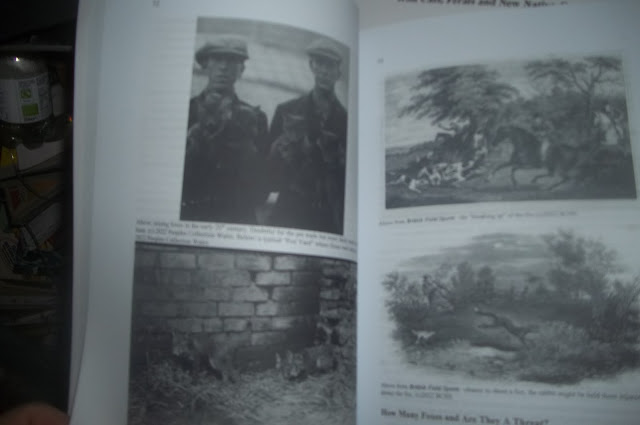Already hailed as British Wildlife classics here are photos of some of the pages from the two books.
Not great photos but they do a lot better in the books (if you buy one or two of them!)
When the Doggerland bridge flooded the British Isles became separated from
Continental Europe and its wildlife developed uniquely. The British Isles, for the purpose of this work includes Ireland, and isolated the wolves on both became what would be island species not affected by the usual island dwarfism. These wolves, after millennia. Became “unwanted” and forests and woodland was burnt down or cut down for the specific purpose of lupicide; the killing of every and any wolf –and there was a bounty for “a job well done”.
At the same time there also developed three unique island species of Old fox from the coyote-like Mountain or Greyhound fox, the slightly smaller but robustly built Mastiff or Bulldog fox and the smaller Common or Cur fox –the latter like today’s red foxes had a symbiotic relationship with humans. These canids were mainly ignored until it was decided that they could provide fur and meat and those things earn money. From that point onward, especially after all other game had been killed off, the fox faced what writers over the centuries referred to as vulpicide –extermination through bounties paid, trapping or hunting and despite all the hunters noting that the Old foxes were nearing extinction they continued to hunt until by the late 1880s the Old were gone and replaced by the New –foxes imported by the thousands every year for the ‘sport’ of fox hunting and this importation also led the the UK seeing the appearance of mange (unknown before the importations).
The travelling British sportsmen went coyote, wolf and jackal hunting and on returning to England wanted to bring a taste of this to “the good old country”. Wolves, jackals and coyotes were set up in hunting territories from where they could learn the lay of the land and provide good sport later. Some hunts even attempted to cross-breed foxes, jackals and Coyotes.
Then there were the legendary –almost mythical– “beasts”; the black beast of Edale, the killer canids of Cavan and the “girt dog” of Ennerdale. In more recent times raccoon dogs and arctic foxes have appeared in the UK; some released for ‘sport’ while others are exotic escapees long since established in the countryside. If you thought you knew what fox hunting was about prepare to be woken up by a sharp slap to the face
and the reality that, by admissions of hunts themselves, this was all about fun and sport and nothing to do with “pest control”.
*********************In 1896 Scottish naturalists and zoologists declared that the true Scottish wild cat had become extinct by the 1860s. What we see today is nothing more than a wild tabby cat. In this work the true history and destruction of wild cats from England, Wales (where hybrids clung on into the 1940s) and Scotland is explored and after decades of research the true look of the wild cat is revealed. The "English Tiger" and "Highland Tiger" truly lived up to that name.
Dogma is finally thrown out.

































No comments:
Post a Comment